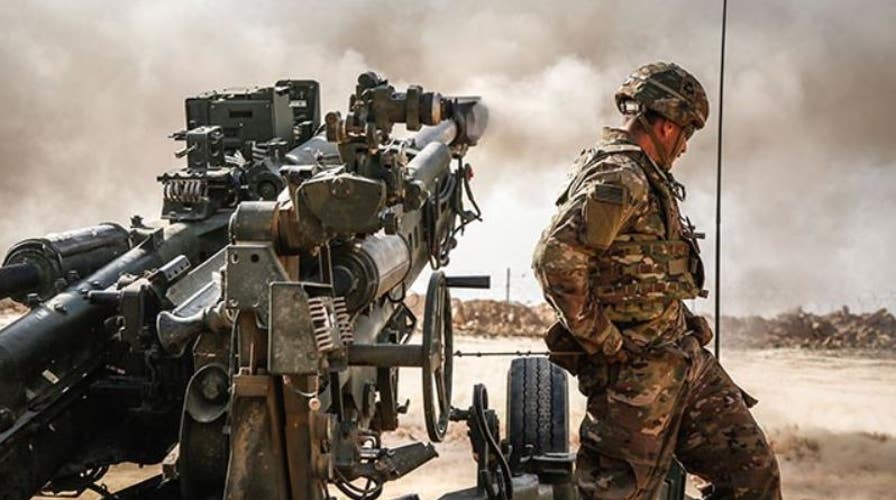Fox News Flash top headlines for April 6
Fox News Flash top headlines are here. Check out what's clicking on Foxnews.com.
New future Army attack helicopters, armored infantry carriers, vehicle-fired counter-drone missiles, hypersonic weapons and high-tech networking technologies for future war -- are all expected to remain largely on-track and ultimately deliver on time despite the coronavirus outbreak, senior service leaders said.
“The Army and its industry partners are still bending metal within our labs and engineering centers and we are still focused on the most critical things, including the safety and security of our soldiers, personnel and health workforce,” Gen. John Murray, Commanding General, Army Futures Command, told reporters April 3.
Some of the current large platform weapons programs are expected, at least as of now, to meet “First Unit Equipped” timelines, including the Future Vertical Lift reconnaissance and attack helicopter, the Optionally Manned Fighting Vehicle (OMFV) armored personnel carrier, Joint Light Tactical Vehicle Humvee replacement, Vehicle-fired missiles for Short Range Air Defense and Army combat communications networks. The service has also completed some crucial future weapons tests and exercises to ensure the Army remains “ready for war.”
“In general we are remaining close to being on track. At this point we think in the long run we can resolve any of the challenges we have on hand,” Dr. Bruce Jette, Assistant Secretary of the Army, Acquisition, Logistics and Technology, told reporters alongside Gen. Murray. “We are keeping the trains running. At the same time, the Army is caring for its people and in the fight against COVID.”
Citing another program which seems to thus far remain on track, Murray mentioned a recent Sensor-to-Shooter Live Fire exercise in Grafenwoehr,, Germany. Conducted by the Army Futures Command Precision, Navigation and Timing Cross-Functional Team, the live fire used space-based sensors to engage and attack “deep targets” in new ways.
PENTAGON MODIFIES 1,500 CONTRACTS IN CORONAVIRUS, SMALL BUSINESS SUPPORT EFFORT
“During these events the team successfully sensed and hit targets at ranges beyond line of sight using satellite capabilities that have not been accessible to ground forces until now,” Robyn Mack, spokeswoman for Army Futures Command, told Warrior in a written statement.
As for some short-term production and development adjustments, Jette explained that while you “can’t telework welding,” there are some instances where activities are being slowed down to keep the “density of workers” down.
Testing, for example, is proving to be a challenging area and, Jette said, the service’s Joint Assault Bridge effort has been paused.
Fortunately, Jette added, 90-percent of the Army personnel who work at Headquarters are able to telework. Most of the work for the OMFV, for instance, is now being done virtually given the program’s current developmental trajectory. While OMFV and other programs remain on track, there has been a short temporary pause at Aberdeen Proving Grounds, Md., based on the maintenance of systems.
“We have rolling estimates as we track the situation,” Jette said.
Many mitigation strategies are still in flux and under consideration, yet many are already in place. For instance, Jette said deliveries of the Army’s new Joint Light Tactical Vehicle may be staggered or spread out to some extent. Nonetheless, Jette said it appears likely that temporary delays will not derail the ultimate production timeline for the vehicles.
“There is a slight pause in some activities. What we need to do is ensure the safety and health of our workers and deliver systems in accordance to the timeline,” Murray added.
Both Jette and Murray emphasized that the weapons development situation is, to a certain extent, still in flux as the Army evaluates additional mitigation strategies and monitors the fast-changing nuances and dangers associated with COVID-19. For example, Jette explained that the service is mindful of having its personnel operate in close quarters for an extended period of time. In addition to some staggered deliveries, rescheduling and work realignments, the Army is also exploring the use of commercial sites for testing.
PENTAGON TAKES AIM AT COVID-19 WITH 8,000 VENTILATORS
Jette emphasized that Army operations simply cannot come to any kind of “halt,” despite the current dangers.
“The Army does not do stuff that is on paper. We have people in the field,” Jette added.
As a way to ensure monitoring of the situation and anticipated or unforeseen changes, Murray and Jette explained that the modernization communities’ COVID-19 Task Force is strengthening close contact with program managers, Army leaders responsible for weapons development (Program Executive Officers) and industry partners.
“This is a daily fight for the Army,” Murray said.
Ultimately, at least thus at this moment, Murray and Jette said the service’s industry partners do not believe they “cannot make up any shortfalls” they are now having to deal with regarding isolations and quarantines.
“In some cases the lines have been thinned and the production rate has gone down, but nothing has gone down to the point where we are at risk of major delays. At this point, we will not miss FUEs (First Unit Equipped),” Jette said.
Finally, many Senior Army futurists and weapons developers are already in the early stages of analyzing the extent to which the COVID 19 outbreak might impact future warfare tactics and emerging weapons systems requirements. For instance, does the COVID-19 pandemic raise new questions about biological warfare? Will it introduce new safety protocols for soldiers in close proximity in a few instances where possible? Of course, this would have to happen in a manner that would not compromise operations, as soldiers in war need to be close to one another? Could COVID-19 lead to new kinds of “hardening” or “sanitizing” procedures woven into requirements for new weapons systems?
PENTAGON DEPLOYS NEW SUB-LAUNCHED, LOW-YEILD NUCLEAR MISSILE
While Murray spoke strategically and did not address specifics at this point -- he did say that the current situation is expected to have a significant effect on future Army operations and modernization.
“We will start considering the long-term impacts of this virus,” Murray said.

